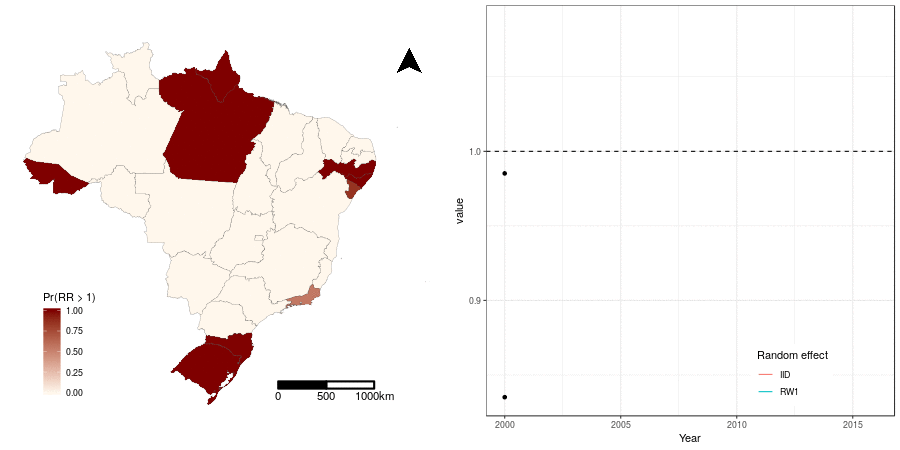Posterior mean excess risk of leptospirosis morbidity, Brazil. 2000–2016. Pr (RR>1) representing the ER: Excess Risk, RR: Relative Risk, IID: Independent and Identically Distributed, RW1: Random Walk of first order. There was a increasing pattern in the cases of Lepto due to the structured effect. Credit: North Carolina State University
Researchers from NC State and the University of São Paulo want to reduce Leptospirosis in Brazil, where the disease is a major public health concern. So they've developed a risk-based priority index for all 26 Brazilian states, to help public health officials target areas most likely to be affected. The priority index ranks the states according to which ones would benefit most from improvements in both public awareness and disease-prevention funding.
Leptospirosis is a tropical, bacterial disease prevalent in South America. Last year an estimated one million illnesses and 58,900 deaths were caused by the disease worldwide, with Brazil accounting for about 40 percent of recorded cases.
The Leptospirosis bacteria thrive in water, and most cases are the result of humans coming into contact with contaminated water. Symptoms include headache and fever, and can be confused with dangerous illnesses like dengue fever or malaria, among others. The bacteria can actively enter the skin, so even standing or wading in contaminated water for long periods can result in infection. In rural areas, risks are primarily related to direct or indirect contact with cattle, who shed the bacteria into water via their urine, whereas in urban areas rat infestation and poor waste management practices increase risk of infection.
"There are more than 250 different serovars of pathogenic Leptospira identified throughout the world, but there is still a major gap in understanding the spatial distribution of this disease," says Gustavo Machado, assistant professor of population health and pathobiology at NC State and co-corresponding author of a paper describing the work. "We do not know, for example, if rural Leptospirosis cases are more dangerous than the urban ones – or even if rural populations are at greater risk than urban populations. And since there's currently no effective vaccine against all the strains, public health officials want to know where the highest risk of infection is in order to direct preventative efforts there."
Machado and co-corresponding author Oswaldo Baquero from the University of São Paulo set out to create a risk index that would rank all 26 Brazilian states in order from highest risk to lowest.
"Currently public health agencies look at the number of cases when they determine risk, but that doesn't give you a realistic picture of overall risk – our model maps where Lepto is occurring and whether it is increasing over time," Machado says.
Machado and Baquero created a risk-calculation model that looks at an area's entire population over a one-year period, and compares the number of confirmed Leptospirosis cases to the number of expected cases during that period to derive a risk rate for that area. They found that Acre, a rural state bordering the Amazon River, was at highest risk for Leptospirosis.
"Focusing only on population density can overlook areas where the risk is actually much higher, even though the number of cases in that area may be lower," Machado says. "Our model provides a much more accurate assessment of actual risk."
The researchers' next steps are to look more closely at risk factors such as waste management, environmental management and illiteracy in order to help government agencies determine how best to allocate resources toward those issues in order to improve public health.
"We are designing a threshold to talk about how to decrease the incidence of Leptospirosis," Machado says, "by helping public health agencies tackle a big problem on smaller, more effective scales."
The research appears in Scientific Reports.
More information: Oswaldo Santos Baquero et al. Spatiotemporal dynamics and risk factors for human Leptospirosis in Brazil, Scientific Reports (2018). DOI: 10.1038/s41598-018-33381-3
Journal information: Scientific Reports
Provided by North Carolina State University




















